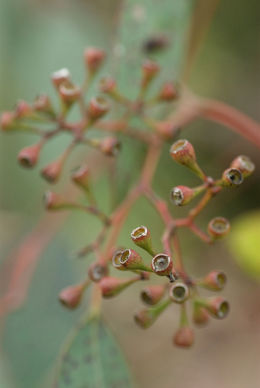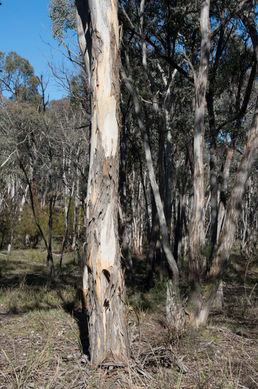
Strategic tree and forest establishment and regeneration on the Southern Tablelands
Eucalyptus polyanthemos
Red Box
MYRTACEAE
Native range: Vic, ACT, NSW Height: 10-20 m Width: 6-8 m Flowering: Spring to summer Fruiting: Summer to autumn Light: Full sun Growth rate: Moderate Soils: Free-draining gravelly and rocky soils Drought tolerance: Moderate Landscape position: Lower slopes, foothills Rainfall range: 550-850 mm Benefits: Red Box (Eucalyptus polyanthemos) is a long-lived evergreen native tree with distinctive dull, light grey-green foliage and box-like bark on the lower trunk that sheds in flakes or strips. The immature leaves are round, leading to it being called the ‘Silver Dollar Eucalyptus’ in foreign markets, where the immature foliage is used in floristry. The adult leaves differ from the immature leaves only in being slightly longer. Red Box flowers are also distinctive, arranged in compound inflorescences of small, cream-coloured flowers. Red Box are robust, attractive trees with dense, spreading canopies that provide good shade when mature. They can tolerate a wide range of soils but will do best well-draining soils in cool sites on slopes. They cope well with frost and wind and are relatively drought tolerant. Red Box have a moderate growth rate, but immature trees can grow quickly in wet seasons. They make excellent street trees and landscaping plants, and unusual in a being a eucalypt with a broad, dense canopy that provides cooling shade. They are a good mid-level addition to shelterbelts in mid-to-lower slope situations and can be used in agroforestry. Trees coppice readily. Red Box tend to have irregular flowering that can be affected by seasonal variation, but in good years the profuse, nectar-rich flowers provide valued food to wildlife and honeybees. Red Box produces a pale, mild-flavoured, viscous honey which does not candy easily. Mature trees provide hollows for animals to shelter and nest in. The timber of Red Box is hard and durable, with some resistance to termite attack. It is mid-red in colour and fine-textured, and though difficult to season, can be worked to a high polished finish. Often used previously for structural use such as railway sleepers, posts and mining props, it can also be used as a specialty timber. It makes excellent firewood Red Box has three subspecies across its full distribution with considerable localised morphological variation. Drawbacks: Moderate fire risk. Too large for domestic gardens. Moderate growth rates can influence timber production. Seedlings can be affected by powdery mildew if humidity high. Uses: Ornamental and landscaping use in parklands and street plantings Shelterbelts Agroforestry Produces good honey Habitat for native biodiversity Specialty timber used in cabinetry, instrument-making and fine craft items Timber for firewood Cut juvenile foliage for floristry Propagation: From seed. Source seed from local geographic range to repair the population gaps created by land clearing and avoid mixing subspecies. Weed risk: None Future climate risks: Delays in flowering or lack of flowering, canopy thinning and slow growth during extended dry years and heatwaves. Branch dieback, limb drop and death of trees in dry, exposed sites. Increase of disease and insect attack die to uneven climate. References AVH (2022). The Australasian Virtual Herbarium, Council of Heads of Australasian Herbaria, https://avh.chah.org.au Beuhne, F.R., The Honey Flora of Victoria (1922) – https://shorturl.at/mLPS1 PlantNET (The NSW Plant Information Network System). Royal Botanic Gardens and Domain Trust, Sydney – https://shorturl.at/iqAS5 Rawal, Deepa S. et al. “Herbarium Records Identify Sensitivity of Flowering Phenology of Eucalypts to Climate: Implications for Species Response to Climate Change.” Austral Ecology 40 (2015) The TAXA Wood Gallery – https://shorturl.at/eKQY8


























